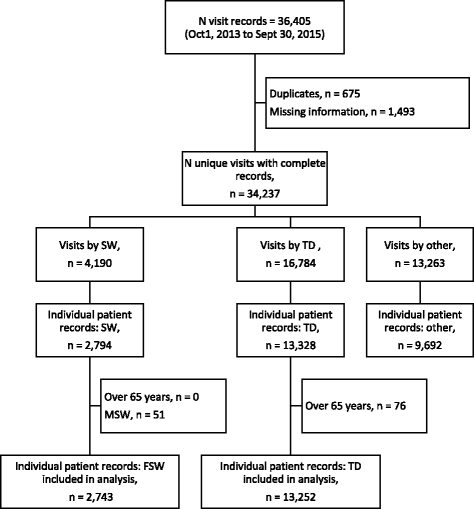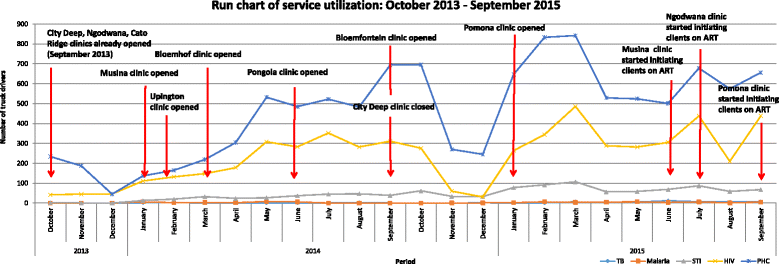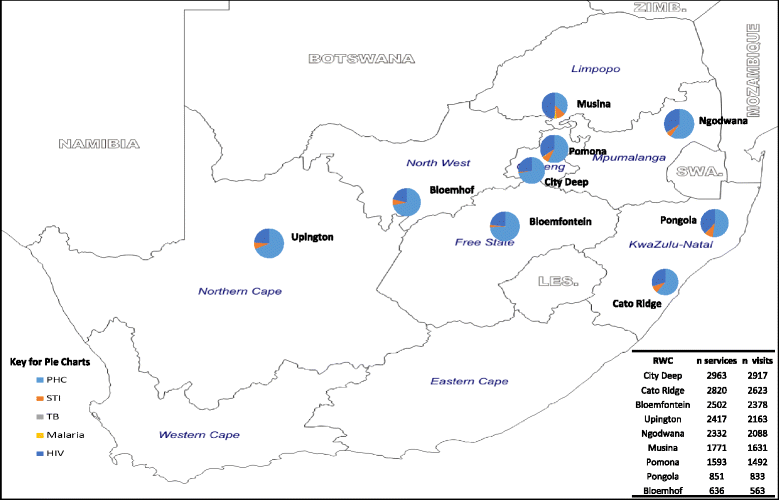Uptake of health services among truck drivers in South Africa: analysis of routine data from nine roadside wellness centres
- PMID: 28903727
- PMCID: PMC5598062
- DOI: 10.1186/s12913-017-2595-3
Uptake of health services among truck drivers in South Africa: analysis of routine data from nine roadside wellness centres
Abstract
Background: Long-distance truck drivers are occupationally susceptible to poor health outcomes. Their patterns of healthcare utilisation and the suitability of healthcare services available to them are not well documented. We report on truck driver healthcare utilisation across South Africa and characterise the client population of the clinics serving them for future service development.
Methods: We analysed anonymised data routinely collected over a two-year period at nine Roadside Wellness Centres. Associations between services accessed and socio-demographic characteristics were assessed using univariable and multivariable logistic regression models.
Results: We recorded 16,688 visits by 13,252 individual truck drivers (average of 1.26 visits/person) who accessed 17,885 services for an average of 1.07 services/visit and 1.35 services/person. The mean age of truck drivers was 39 years. Sixty-seven percent reported being in stable relationships. The most accessed services were primary healthcare (PHC)(62%) followed by HIV (32%). Low proportions (≤6%) accessed STI,TB and malaria services. Most visits were characterised by only one service being accessed (93%, n = 15,523/16,688). Of the remaining 7% of visits, up to five services were accessed per visit and the combination of TB /HIV services in one visit remained extremely low (<1%, n = 14/16,688). Besides PHC services at the beginning of the reporting period, all service categories displayed similar seasonal utilisation trends(i.e. service utilisation peaked in the immediate few months post clinics opening and substantially decreased before holidays). Across all service categories, younger truck drivers, those with a stable partner currently, and those of South African origin were the main clinic attendees. Older truck drivers (≥40 years) were more likely to access TB and PHC services, yet less likely to access HIV and STI services. Those with stable partners were less likely to access STI and TB services but more likely to access malaria and PHC services. South African attendees were more likely to access PHC, while attendees from other nationalities were more likely to access HIV and malaria services.
Conclusions: This utilisation analysis shows that tailored services assist in alleviating healthcare access challenges faced by truck drivers, but it underscores the importance of ensuring that service packages and clinics speak to truck drivers' needs in terms of services offered and clinic location.
Keywords: Access; Healthcare; Programme; Roadside Wellness Centre; Service delivery; South Africa; Truck drivers.
Conflict of interest statement
Ethics approval and consent to participate
Ethics approval was obtained from the University of the Witwatersrand Human Research Ethics Committee (M140506) on 30 May 2014. In addition, North Star Alliance and Wits Reproductive Health and HIV Institute signed a data user’s agreement on 5 May 2014 to ensure that data was appropriately handled throughout the data management cycle.
Consent for publication
Not applicable.
Competing interests
The following author has competing interests: Paul Matthew is the Regional Director, Southern Africa at North Star Alliance. All other authors have declared that they have no competing interests.
Publisher’s Note
Springer Nature remains neutral with regard to jurisdictional claims in published maps and institutional affiliations.
Figures



References
-
- Lalla-Edward ST, Gomez GB. Enroute to a healthy truck driver population. HIV Nursing Matters. 2015;6(2):20–23.
-
- DeVries H, VanDeKlunderty J, Wagelmansz APM. Health benefits of roadside healthcare services. 2013.
-
- Apostolopoulos Y, Sönmez S, Shattell M, Gonzales C, Fehrenbacher C. Health survey of U.S. long-haul truck drivers: work environment, physical health, and healthcare access. Work. 2013;4(1):113–123. - PubMed
MeSH terms
Grants and funding
LinkOut - more resources
Full Text Sources
Other Literature Sources
Medical

